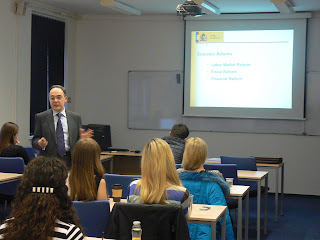A conversation with UNYP
General Manager Sotiris Foutsis
By
Michal K.
Most
UNYP students know General Manager Sotiris Foutsis as the man from Greece who
occupies a big office on the fourth floor – and not much more. UNYPRESS paid
him a visit to learn more about the man and his hopes and dreams for UNYP.
Foutsis proved to be a thoughtful and gracious subject, at one point even
providing the interviewer with a pen.
UNYPRESS: Why did you come all the way
from Greece to run a school in Prague?
SOTIRIS FOUTSIS: To put it simply, I was
assigned here. I have 10 years of experience in various managerial positions. I
worked in our school in Athens, and then they sent me here.
UNYPRESS: Is it true that you are the son of Elias Foutsis, the
man who started the whole New York University empire in Europe? How many
universities are there all together?
SF: Yes, that’s true. Right now
there are four universities. Along with Prague there is also Belgrade, Tirana
and Athens, but we collaborate with many other universities.
UNYPRESS: Do you plan to expand the
“lineup” anytime soon?
SF: We are always looking for new
possibilities to improve, so it is possible. But right now we are very cautious
because of the economic situation in the world.
UNYPRESS: Speaking of improvement, I am
sure many students would like to know when we will see the new UNYP building. The
rumors have been around for a while now.
 |
| With the twins in Berlin |
UNYPRESS: While we are talking about
future plans, what is your vision for UNYP?
SF: (After a pause) My vision has pretty much materialized
already. Our aim is to offer the best,
or at least one of the best, universities in the region, which UNYP is. We
offer quality education and the success of our alumni is a major indicator. I
would still like to improve the internal quality.
UNYPRESS: What do you think sets UNYP
apart from other English-language universities in Prague?
SF: I think UNYP is quite unique
in what it offers, because for example Prague College is not accredited by the
Czech government. We are. And I honestly believe that the quality of education
we offer is much better.
UNYPRESS: As good as UNYP may be, in the
Czech Republic there is always the stigma of being a private school. Many
people say that UNYP is a school for rich kids who don’t have to do anything
for their grades because the school just wants their money. What is your
reaction to this?
SF: (With emphasis) I challenge
anyone to come here and see how we do things; they will see that is not true.
Unfortunately, there are many schools which function like that. But we are not
one of them. We dismiss a number of students every semester. Many schools don’t
do that.
UNYPRESS: I remember on orientation day
for new students you said that if we end up in your office, we are in serious
trouble. Are you a tough boss?
SF: (Laughs) You would have to
ask the employees, but I have a philosophy of a pleasant environment and good
teamwork atmosphere. But of course to get thing done, you sometimes need to
create some pressure.
UNYPRESS: What has been your biggest
challenge so far as general manager of
UNYP?
SF: The biggest problem was to
change the mentality of the way people perceive UNYP. It has been four a half
years since I came here, and it took that long to explain to people that UNYP
is an international school. We are not a Czech school.
UNYPRESS: How do you recruit professors?
SF: We try to have international
professors. Since Prague has quite a large expat community, it’s not a problem.
If we cannot find any here, we try to get people from abroad. We also have professors
coming from ESC.
UNYPRESS: On a lighter note, what are
your hobbies?
SF: I like any type of sport
whenever possible. Many students can see me at UNYP sports events, only there
is not that much time because of the kids. I also like movies and traveling.
UNYPRESS: I understand that your family
still lives in Greece. How many kids do you have?
SF: My family already moved here.
I have three kids.
UNYPRESS: And what is your favorite movie and travel destination?
SF: For the film, Braveheart. But I don’t have a favorite
place to go. I like the exploration aspect of traveling.





















